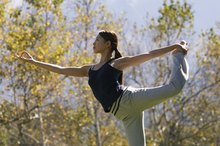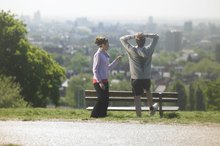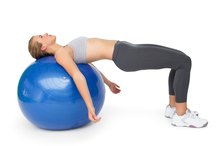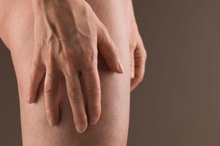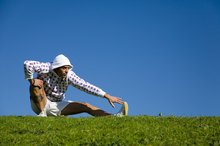How to Stretch the Trapezius Muscle
The trapezius muscle covers a large area of the back, neck and shoulders. Its main function is to move the scapula, or shoulder blade, and help support your arms. If you spend a lot of time sitting at a desk or behind the wheel of a car, the trapezius muscle can shorten and tighten, which affects mobility in your neck. Stretching this large muscle keeps it loose and pliable, relieves tension and preserves or restores neck and shoulder health.
Stand with your feet hip-width apart or sit in a firm, stable chair. Interlock your fingers behind your head and open your elbows to the side. Gently press your head forward, drawing your chin toward your chest. Avoid rounding your shoulders forward, as this reduces the effectiveness of the stretch.
How Does Exercise Improve Your Posture?
Learn More
Stand inside a door frame with your right shoulder adjacent to the frame. Position your feet shoulder-width apart with your toes pointing forward. Extend your left arm across your body toward the right shoulder. Pointing your right thumb down, grab hold of the door frame at shoulder level. Rotate your trunk slightly to the left until you feel a stretch behind your left shoulder. Repeat the stretch with your right arm extended toward your left shoulder.
Stand facing the left side of a door frame, positioning your feet arms-length away from the frame. Lower yourself into a squat position. With your right hand, grab the inside of the door frame at shoulder level. Keeping your right arm straight and your feet firmly planted, lower your hips toward the floor and draw them away from the door frame. You'll feel tension along the back of your right shoulder. Repeat the exercise with your left hand on the door frame to stretch your left trap.
How to Increase Flexibility in My Big Toes
Learn More
Stand upright with your feet shoulder-width apart. Bring your left arm diagonally across the front of your body, drawing your left hand toward your right hip. Grab hold of your left elbow with your right hand and gently draw the elbow down and toward the right side of your body. Repeat on the other side, pulling your right elbow down and toward the left side of your body.
Tips
Hold every stretch for 15 to 30 seconds and repeat up to four times before switching sides. Breathe evenly to help release stress and tension and achieve a deeper, more effective stretch.
Warnings
Never bounce or force the stretch. Move in and out of the stretch slowly and maintain total control of your movements to avoid injury.
Related Articles
References
- Yoga Journal: Yoga Anatomy -- Dump the Slump
- Stretching Anatomy; Arnold J. Nelson and Jouko Kokkonen
- Lurati AR. Health issues and injury risks associated with prolonged sitting and sedentary lifestyles. Workplace Health Saf. 2018;66(6):285-290. doi:10.1177/2165079917737558
- Nakphet N, Chaikumarn M, Janwantanakul P. Effect of different types of rest-break interventions on neck and shoulder muscle activity, perceived discomfort and productivity in symptomatic VDU operators: A randomized controlled trial. Int J Occup Saf Ergon. 2014;20(2):339-53. doi:10.1080/10803548.2014.11077048
- Cooley D, Pedersen S. A pilot study of increasing nonpurposeful movement breaks at work as a means of reducing prolonged sitting. J Environ Public Health. 2013;2013:128376. doi:10.1155/2013/128376
- Daneshmandi H, Choobineh A, Ghaem H, Karimi M. Adverse effects of prolonged sitting behavior on the general health of office workers. J Lifestyle Med. 2017;7(2):69-75. doi:10.15280/jlm.2017.7.2.69
- Henning RA, Jacques P, Kissel GV, Sullivan AB, Alteras-Webb SM. Frequent short rest breaks from computer work: Effects on productivity and well-being at two field sites. Ergonomics. 1997;40(1):78-91. doi:10.1080/001401397188396
- Ylinen J, Kautiainen H, Wirén K, Häkkinen A. Stretching exercises vs manual therapy in treatment of chronic neck pain: A randomized, controlled cross-over trial. J Rehabil Med. 2007;39(2):126-32. doi:10.2340/16501977-0015
- National Institute of Arthritis and Musculoskeletal and Skin Diseases. Shoulder Problems: What are the types of shoulder problems?. Updated April 2014.
- National Institute of Arthritis and Musculoskeletal and Skin Diseases. How are shoulder problems treated?. Updated April 2014.
Writer Bio
Based in the Rocky Mountains, Melanie Woodland has been writing health- and fitness-related articles since 2004. She holds her Bachelor of Science from Colorado State University, personal training certification from A.C.E. and group exercise certifications. She has completed numerous training regimens for all populations.
